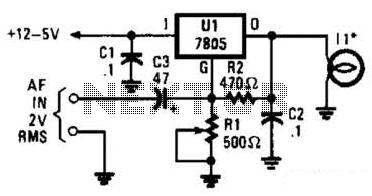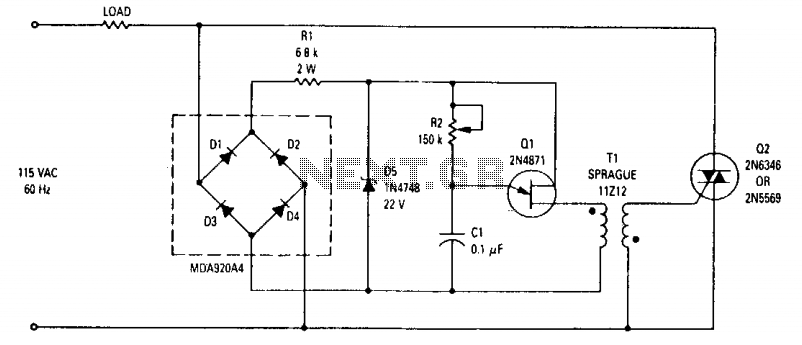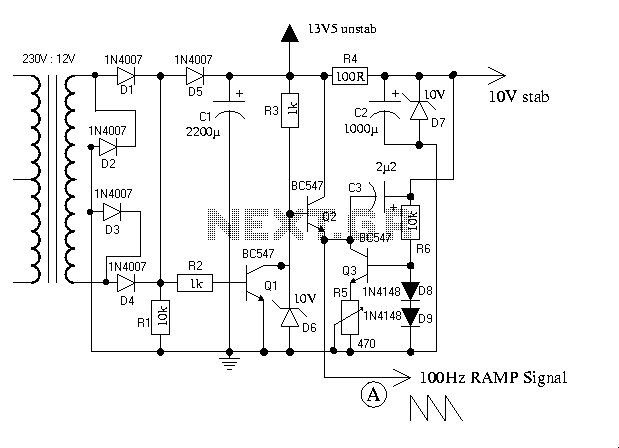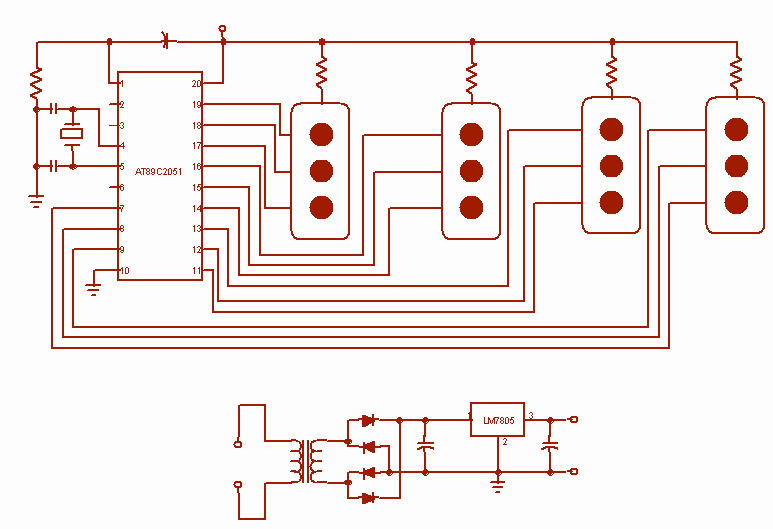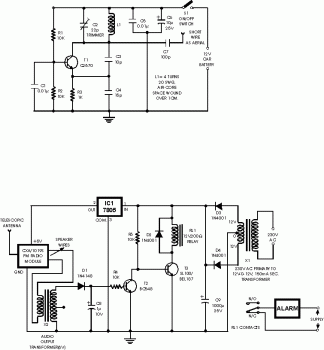
Emergency Light and Alarm
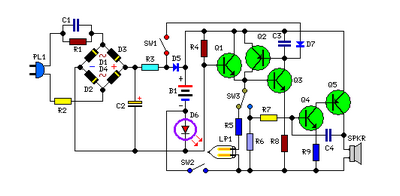
This circuit is permanently connected to a mains socket for the trickle charging of Ni-Cd batteries. In the event of a power outage, the lamp automatically turns on. Alternatively, an alarm sounder can be selected instead of the lamp. When power is restored, either the lamp or alarm is turned off. A switch allows for a latch-up function, enabling continued operation of the lamp or alarm even after power is restored. The mains voltage is reduced to approximately 12V DC at the terminals of capacitor C2 through the reactance provided by capacitor C1 and a diode bridge (D1-D4), eliminating the need for a mains transformer. The trickle charging current for battery B1 is supplied by series resistor R3, diode D5, and green LED D6, which also indicates the presence of mains supply and proper battery charging. Transistors Q2 and Q3 form a self-latching pair that activates during a power outage. In this scenario, the biasing of transistor Q1 becomes positive, turning on the self-latching pair. Depending on the position of switch SW3 in the circuit diagram, the lamp can illuminate via normally closed switch SW2; alternatively, if set differently, a square wave audio frequency generator made up of transistors Q4, Q5, and associated components is triggered to drive the loudspeaker. Caution is advised, as the circuit is connected to 230Vac mains, exposing certain components to lethal voltages. It is essential to avoid contact with the circuit while it is plugged in and to house it in a plastic enclosure.
The circuit design features a robust mechanism for ensuring that essential lighting or alarm functions remain operational during power interruptions. The trickle charging system is efficiently designed to maintain battery health without the bulk of a transformer, using capacitive reactance to step down the voltage. The self-latching mechanism, formed by Q2 and Q3, provides a reliable method for retaining the state of the lamp or alarm in the event of power restoration, ensuring that the user is alerted even after the mains supply returns.
The choice between a lamp and an alarm sounder allows for flexibility in application, catering to different user needs. The use of a square wave generator for audio output enhances the alarm functionality, making it suitable for a variety of alerting scenarios. The inclusion of LED D6 serves a dual purpose, providing both visual feedback on the operational status of the circuit and acting as a monitoring tool for battery charging, which is critical for maintaining the longevity of the Ni-Cd batteries.
Safety measures are paramount in this design, given the direct connection to mains voltage. The circuit should only be handled with caution, and appropriate enclosures must be utilized to prevent accidental contact with high-voltage components. Overall, this circuit represents a practical solution for emergency lighting and alarm systems, combining efficiency, functionality, and safety in its design.This circuit is permanently plugged into a mains socket and NI-CD batteries are trickle-charged. When a power outage occurs, the lamp automatically illuminates. Instead of illuminating a lamp, an alarm sounder can be chosen. When power supply is restored, the lamp or the alarm is switched-off. A switch provides a latch-up function, in order to extend lamp or alarm operation even when power is restored. Mains voltage is reduced to about 12V DC at C2`s terminals, by means of the reactance of C1 and the diode bridge (D1-D4). This avoids the use of a mains transformer. Trickle-charging current for the battery B1 is provided by the series resistor R3, D5 and the green LED D6 that also monitors the presence of mains supply and correct battery charging.
Q2 & Q3 form a self-latching pair that start operating when a power outage occurs. In this case, Q1 biasing becomes positive, so this transistor turns on the self latching pair. If SW3 is set as shown in the circuit diagram, the lamp illuminates via SW2, which is normally closed; if set the other way, a square wave audio frequency generator formed by Q4, Q5 and related components is activated, driving the loudspeaker. Warning! The circuit is connected to 230Vac mains, then some parts in the circuit board are subjected to lethal potential!.
Avoid touching the circuit when plugged and enclose it in a plastic box. 🔗 External reference
The circuit design features a robust mechanism for ensuring that essential lighting or alarm functions remain operational during power interruptions. The trickle charging system is efficiently designed to maintain battery health without the bulk of a transformer, using capacitive reactance to step down the voltage. The self-latching mechanism, formed by Q2 and Q3, provides a reliable method for retaining the state of the lamp or alarm in the event of power restoration, ensuring that the user is alerted even after the mains supply returns.
The choice between a lamp and an alarm sounder allows for flexibility in application, catering to different user needs. The use of a square wave generator for audio output enhances the alarm functionality, making it suitable for a variety of alerting scenarios. The inclusion of LED D6 serves a dual purpose, providing both visual feedback on the operational status of the circuit and acting as a monitoring tool for battery charging, which is critical for maintaining the longevity of the Ni-Cd batteries.
Safety measures are paramount in this design, given the direct connection to mains voltage. The circuit should only be handled with caution, and appropriate enclosures must be utilized to prevent accidental contact with high-voltage components. Overall, this circuit represents a practical solution for emergency lighting and alarm systems, combining efficiency, functionality, and safety in its design.This circuit is permanently plugged into a mains socket and NI-CD batteries are trickle-charged. When a power outage occurs, the lamp automatically illuminates. Instead of illuminating a lamp, an alarm sounder can be chosen. When power supply is restored, the lamp or the alarm is switched-off. A switch provides a latch-up function, in order to extend lamp or alarm operation even when power is restored. Mains voltage is reduced to about 12V DC at C2`s terminals, by means of the reactance of C1 and the diode bridge (D1-D4). This avoids the use of a mains transformer. Trickle-charging current for the battery B1 is provided by the series resistor R3, D5 and the green LED D6 that also monitors the presence of mains supply and correct battery charging.
Q2 & Q3 form a self-latching pair that start operating when a power outage occurs. In this case, Q1 biasing becomes positive, so this transistor turns on the self latching pair. If SW3 is set as shown in the circuit diagram, the lamp illuminates via SW2, which is normally closed; if set the other way, a square wave audio frequency generator formed by Q4, Q5 and related components is activated, driving the loudspeaker. Warning! The circuit is connected to 230Vac mains, then some parts in the circuit board are subjected to lethal potential!.
Avoid touching the circuit when plugged and enclose it in a plastic box. 🔗 External reference
